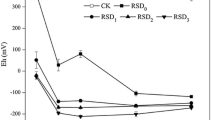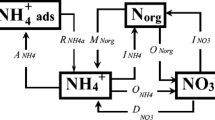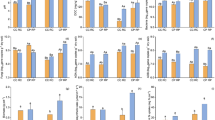Abstract
Reductive soil disinfestation (RSD) is proposed as a pre-plant, non-chemical soil disinfestation technique to control several soilborne phytosanitary issues. However, limited information is available on the evaluation of greenhouse gas (GHG) balance and soil quality during the soil remediation process as affected by RSD method. A 44-day field experiment including four different treatments was conducted to investigate the effects of conventional RSD and field-aged biochar-amended RSD on GHG balance and soil quality in a degraded vegetable field. Results showed that the conventional RSD application can significantly decrease the soil nitrate (NO3−) concentrations and electrical conductivity (EC) and oxidation-reduction potential (Eh) by 51.4–67.3%, 5.3–23.6%, and 10.9–15.1%, respectively, while significantly increase soil pH and cation exchange capacity (CEC) by 0.37–0.42 units and 7.8–32.2%, respectively, in relation to the control (CK). Compared with the conventional RSD treatment, aged biochar-amended RSD significantly reduced soil NO3− concentrations, EC and Eh. No significant differences on CH4 emissions were observed among all the treatments during the experimental period. However, the conventional RSD application significantly increased the cumulative nitrous oxide (N2O) and carbon dioxide (CO2) emissions by 66.2–124.7% and 64.3–130.0%, respectively, and thus resulted in a significant GHG balance of 64.1–130.1% in relation to the CK. On the contrary, although resulted in more N2O emissions compared with the conventional RSD treatment, aged biochar-amended RSD significantly reduced the cumulative CO2 emissions and thus had an overall decrease in GHG balance by 20.7–28.7%. Therefore, aged biochar-amended RSD can simultaneously achieve lower GHG balance and better improvement of soil quality in degraded vegetable field, and thus can be utilized as an effective technology for soil remediation in intensive vegetable production.






Similar content being viewed by others
References
Beauchamp EG, Trevors JT, Paul JW (1989) Carbon sources for bacterial denitrification. In Adv Soil Sci (pp. 113–142). Springer New York
Blok WJ, Lamers JG, Termorshuizen AJ, Bollen GJ (2000) Control of soilborne plant pathogens by incorporating fresh organic amendments followed by tarping. Phytopathology 90(3):253–259
Butler DM, Rosskopf EN, Kokalis-Burelle N, Albano JP, Muramoto J, Shennan C (2012) Exploring warm-season cover crops as carbon sources for anaerobic soil disinfestation (ASD). Plant Soil 355(1–2):149–165
Cao ZH, Huang JF, Zhang CS, Li AF (2004) Soil quality evolution after land use change from paddy soil to vegetable land. Environ Geochem Health 26(2):97–103
Cayuela ML, Sánchez-Monedero MA, Roig A, Hanley K, Enders A, Lehmann J (2013) Biochar and denitrification in soils: when, how much and why does biochar reduce N2O emissions? Sci Rep 3:1732
Chan KY, Dorahy CG, Tyler S, Wells AT, Milham PP, Barchia I (2007) Phosphorus accumulation and other changes in soil properties as a consequence of vegetable production, Sydney region, Australia. Soil Res 45(2):139–146
Chen X, Cui Z, Fan M, Vitousek P, Zhao M, Ma W, Wang Z, Zhang W, Yan X, Yang J, Deng X, Gao Q, Zhang Q, Guo S, Ren J, Li S, Ye Y, Wang Z, Huang J, Tang Q, Sun Y, Peng X, Zhang J, He M, Zhu Y, Xue J, Wang G, Wu L, An N, Wu L, Ma L, Zhang W, Zhang F (2014) Producing more grain with lower environmental costs. Nature 514:486–489
Chen Z, Zhang J, Xiong Z, Pan G, Müller C (2016) Enhanced gross nitrogen transformation rates and nitrogen supply in paddy field under elevated atmospheric carbon dioxide and temperature. Soil Biol Biochem 94:80–87
Clough TJ, Condron LM (2010) Biochar and the nitrogen cycle: introduction. J Environ Qual 39(4):1218–1223
CRGCST (Cooperative Research Group on Chinese Soil Taxonomy): Chinese Soil Taxonomy (3rd Edition), Science Press, Beijing, New York, 2001
Darilek JL, Huang B, Wang Z, Qi Y, Zhao Y, Sun W, Gu Z, Shi X (2009) Changes in soil fertility parameters and the environmental effects in a rapidly developing region of China. Agric Ecosyst Environ 129(1):286–292
Davidson EA, Verchot LV (2000) Testing the hole-in-the-pipe model of nitric and nitrous oxide emissions from soils using the TRAGNET database. Glob Biogeochem Cycles 14(4):1035–1043
Duan P, Zhang X, Zhang Q, Wu Z, Xiong Z (2018) Field-aged biochar stimulated N2O production from greenhouse vegetable production soils by nitrification and denitrification. Sci Total Environ 642:1303–1310
Food and Agriculture Organization (FAO) (2015) FAOSTAT (food and agriculture organization statistical data) statistical yearbook Vol. 4, available at: http://faostat.fao.org. [2018-3-12]
Gioia F, Ozores-Hampton M, Zhao X, Thomas J, Wilson P, Li Z (2017) Anaerobic soil disinfestation impact on soil nutrients dynamics and nitrous oxide emissions in fresh-market tomato. Agric Ecosyst Environ 240:194–205
Havlin JL, Beaton JD, Tisdale SL, Nelson WL (2005) Soil fertility and fertilizers: an introduction to nutrient management, 7th edition. Pearson/Prentice Hall. Upper Saddle River, NJ. pp 48–55, 338–342, 412–416
Hazelton PA, Murphy BW (2007) Interpreting soil test results: what do all the numbers mean? CSIRO publishing
IPCC (2013) Climate change 2013: the physical science basis: working group I contribution to the fifth assessment report of the intergovernmental panel on climate change. Cambridge University Press, Cambridge
Jones DL, Murphy DV, Khalid M, Ahmad W, Edwards-Jones G, DeLuca TH (2011) Short-term biochar-induced increase in soil CO2 release is both biotically and abiotically mediated. Soil Biol Biochem 43(8):1723–1731
Ju XT, Kou CL, Christie P, Dou ZX, Zhang FS (2007) Changes in the soil environment from excessive application of fertilizers and manures to two contrasting intensive cropping systems on the North China plain. Environ Pollut 145(2):497–506
Ju XT, Xing GX, Chen XP, Zhang SL, Zhang LJ, Liu XJ, Cui ZL, Yin B, Christie P, Zhu ZL, Zhang FS (2009) Reducing environmental risk by improving N management in intensive Chinese agricultural systems. Proc Natl Acad Sci 106(9):3041–3046
Lamers JG, Wanten PJ, Blok WJ (2004) Biological soil disinfestation: a safe and effective approach for controlling soilborne pests and diseases. Agroindustria 3(3):289–291
Li B, Fan CH, Xiong ZQ, Li QL, Zhang M (2015b) The combined effects of nitrification inhibitor and biochar incorporation on yield-scaled N2O emissions from an intensively managed vegetable field in southeastern China. Biogeosciences 12:2003–2017
Li B, Fan CH, Zhang H, Chen ZZ, Sun LY, Xiong ZQ (2015a) Combined effects of nitrogen fertilization and biochar on the net global warming potential, greenhouse gas intensity and net ecosystem economic budget in intensive vegetable agriculture in southeastern China. Atmos Environ 100:10–19
Li B, Bi Z, Xiong Z (2017) Dynamic responses of nitrous oxide emission and nitrogen use efficiency to nitrogen and biochar amendment in an intensified vegetable field in southeastern China. Global Change Biol Bioenergy 9:400–413
Liang B, Lehmann J, Solomon D, Kinyangi J, Grossman J, O’neill B, Skjemstad JO, Thies J, Luizão FJ, Petersen J, Neves EG (2006) Black carbon increases cation exchange capacity in soils. Soil Sci Soc Am J 70(5):1719–1730
Liska AJ, Yang H, Milner M, Goddard S, Blancocanqui H, Pelton M, Fang X, Zhu H, Suyker A (2014) Biofuels from crop residue can reduce soil carbon and increase CO2 emissions. Nat Clim Chang 4(5):398–401
Lu RK (2000) Soil agro-chemical analyses, pp. 12–311. Agricultural Technical Press of China, Beijing, China (In Chinese)
Meng T, Zhu T, Zhang J, Cai Z (2015a) Effect of liming on sulfate transformation and sulfur gas emissions in degraded vegetable soil treated by reductive soil disinfestation. J Environ Sci 36:112–120
Meng T, Zhu T, Zhang J, Xie Y, Sun W, Yuan L, Cai Z (2015b) Liming accelerates the NO3 − removal and reduces N2O emission in degraded vegetable soil treated by reductive soil disinfestation (RSD). J Soils Sediments 15(9):1968–1976
Messiha NA, van Diepeningen AD, Wenneker M, van Beuningen AR, Janse JD, Coenen TG, Termorshuizen AJ, Bruggen AHC, Blok WJ (2007) Biological soil disinfestation (BSD), a new control method for potato brown rot, caused by Ralstonia solanacearum race 3 biovar 2. Eur J Plant Pathol 117(4):403–415
Mia S, Dijkstra F, Singh B (2017) Aging induced changes in biochar’s functionality and adsorption behavior for phosphate and ammonium. Environ Sci Technol 51(15):8359–8367
Momma N (2008) Biological soil disinfestation (BSD) of soilborne pathogens and its possible mechanisms. Jpn Agric Res Q: JARQ 42(1):7–12
Momma N, Kobara Y, Uematsu S, Kita N, Shinmura A (2013) Development of biological soil disinfestations in Japan. Appl Microbiol Biotechnol 97(9):3801–3809
Mutegi JK, Munkholm LJ, Petersen BM, Hansen EM, Petersen SO (2010) Nitrous oxide emissions and controls as influenced by tillage and crop residue management strategy. Soil Biol Biochem 42(10):1701–1711
Philippot L, Hallin S, Schloter M (2007) Ecology of denitrifying prokaryotes in agricultural soil. Adv Agron 96:249–305
Prommer J, Wanek W, Hofhansl F, Trojan D, Offre P, Urich T, Schleper C, Sassmann S, Kitzler B, Soja G, Hood-Nowotny RC (2014) Biochar decelerates soil organic nitrogen cycling but stimulates soil nitrification in a temperate arable field trial. PLoS One 9(1):e86388
Prost K, Borchard N, Siemens J, Kautz T, Séquaris JM, Möller A, Amelung W (2013) Biochar affected by composting with farmyard manure. J Environ Qual 42(1):164–172
Qu Z, Wang J, Almøy T, Bakken LR (2014) Excessive use of nitrogen in Chinese agriculture results in high N2O/ (N2O+ N2) product ratio of denitrification, primarily due to acidification of the soils. Glob Chang Biol 20(5):1685–1698
Rogovska N, Laird D, Cruse R, Fleming P, Parkin T, Meek D (2011) Impact of biochar on manure carbon stabilization and greenhouse gas emissions. Soil Sci Soc Am J 75(3):871–879
Rondon MA, Lehmann J, Ramírez J, Hurtado M (2007) Biological nitrogen fixation by common beans (Phaseolus vulgaris L.) increases with biochar additions. Biol Fertil Soils 43(6):699–708
Shuman LM (1999) Organic waste amendments effect on zinc fractions of two soils. J Environ Qual 28(5):1442–1447
Singh BP, Hatton BJ, Singh B, Cowie AL, Kathuria A (2010) Influence of biochars on nitrous oxide emission and nitrogen leaching from two contrasting soils. J Environ Qual 39(4):1224–1235
Singh B, Fang Y, Johnston C (2016) A Fourier-transform infrared study of biochar aging in soils. Soil Sci Soc Am J 80(3):613–622
Verhoeven E, Six J (2014) Biochar does not mitigate field-scale N2O emissions in a northern California vineyard: an assessment across two years. Agric Ecosyst Environ 191:27–38
Wan Y, Ju X, Ingwersen J, Schwarz U, Stange CF, Zhang F, Streck T (2009) Gross nitrogen transformations and related nitrous oxide emissions in an intensively used calcareous soil. Soil Sci Soc Am J 73(1):102–112
Wang H, Dong YH, Li DC, Velde B, An Q, Guo ZX, Zuo QD (2008) Evolution of soil chemical properties in the past 50 years in the tai Lake region, China. Soil Tillage Res 100(1):54–59
Wang J, Chen Z, Ma Y, Sun L, Xiong Z, Huang Q (2013) Methane and nitrous oxide emissions as affected by organic–inorganic mixed fertilizer from a rice paddy in Southeast China. J Soils Sed 13(8):1408–1417
Wang J, Dokohely ME, Xiong Z, Kuzyakov Y (2016) Contrasting effects of aged and fresh biochars on glucose-induced priming and microbial activities in paddy soil. J Soils Sediments 16(1):191–203
Wang X, Zou C, Gao X, Guan X, Zhang W, Zhang Y, Shi X, Chen X (2018) Nitrous oxide emissions in chinese vegetable systems: a meta-analysis. Environ Pollut 239:375–383
Wu Z, Zhang X, Dong Y, Xu X, Xiong Z (2018) Microbial explanations for field-aged biochar mitigating greenhouse gas emissions during a rice-growing season. Environ Sci Pollut Res 25(31):31307–31317
Xiong Z, Xie Y, Xing G, Zhu Z, Butenhoff C (2006) Measurements of nitrous oxide emissions from vegetable production in China. Atmos Environ 40(12):2225–2234
Yoo MS, James BR (2002) Zinc extractability as a function of pH in organic waste-amended soils. Soil Sci 167(4):246–259
Zheng X, Mei B, Wang Y, Xie B, Wang Y, Dong H (2008) Quantification of N2O fluxes from soil–plant systems may be biased by the applied gas chromatograph methodology. Plant Soil 311(1–2):211–234
Zhu T, Dang Q, Zhang J, Müller C, Cai Z (2014) Reductive soil disinfestation (RSD) alters gross N transformation rates and reduces NO and N2O emissions in degraded vegetable soils. Plant Soil 382(1–2):269–280
Acknowledgments
We sincerely appreciate the anonymous reviewer and P. Garrigues for the critical and valuable comments to help improve this manuscript.
Funding
This work was jointly supported by the Special Fund for Agro-Scientific Research in the Public Interest (201503106), National Natural Science Foundation of China (41471192, 41807021), and the Ministry of Science and Technology (2013BAD11B01).
Author information
Authors and Affiliations
Corresponding author
Additional information
Responsible editor: Philippe Garrigues
Publisher’s Note
Springer Nature remains neutral with regard to jurisdictional claims in published maps and institutional affiliations.
Electronic supplementary material
Fig. S1
(PNG 236 kb)
Rights and permissions
About this article
Cite this article
Li, B., Zhou, J., Lu, Y. et al. Field-aged biochar reduces the greenhouse gas balance in a degraded vegetable field treated by reductive soil disinfestation. Environ Sci Pollut Res 26, 10609–10620 (2019). https://doi.org/10.1007/s11356-019-04130-4
Received:
Accepted:
Published:
Issue Date:
DOI: https://doi.org/10.1007/s11356-019-04130-4




